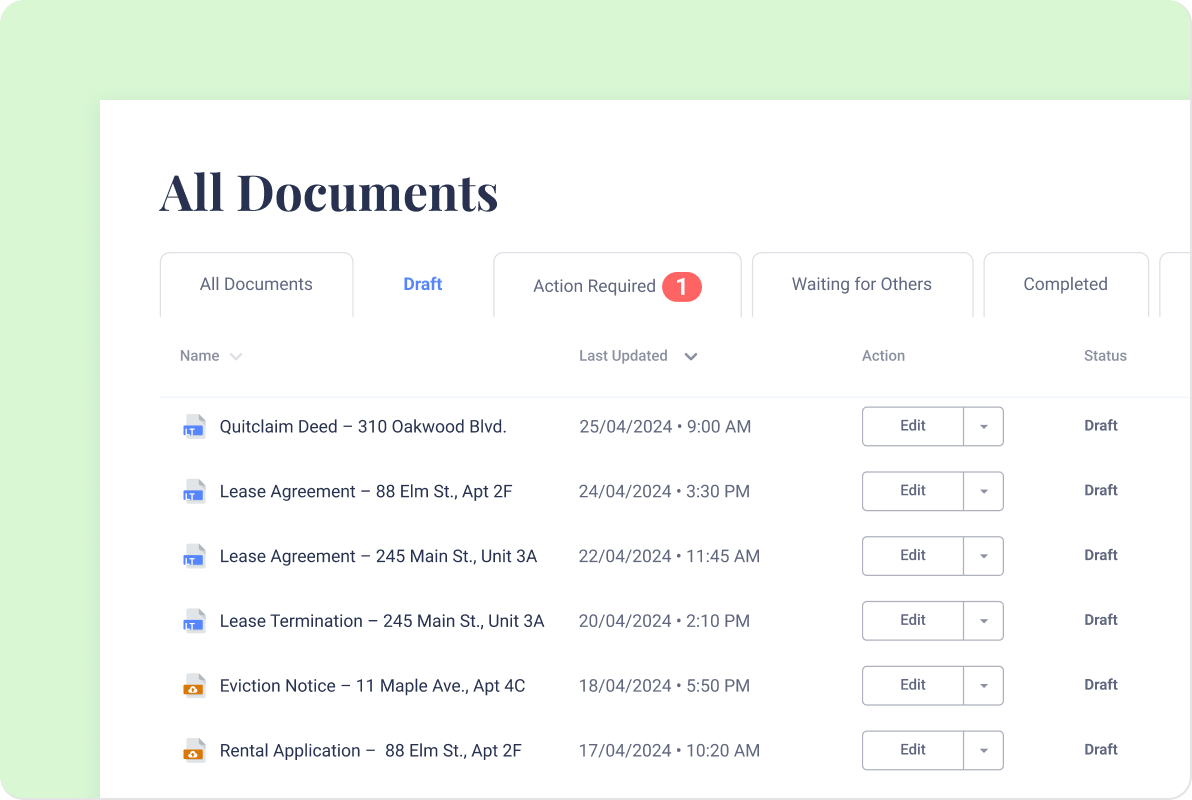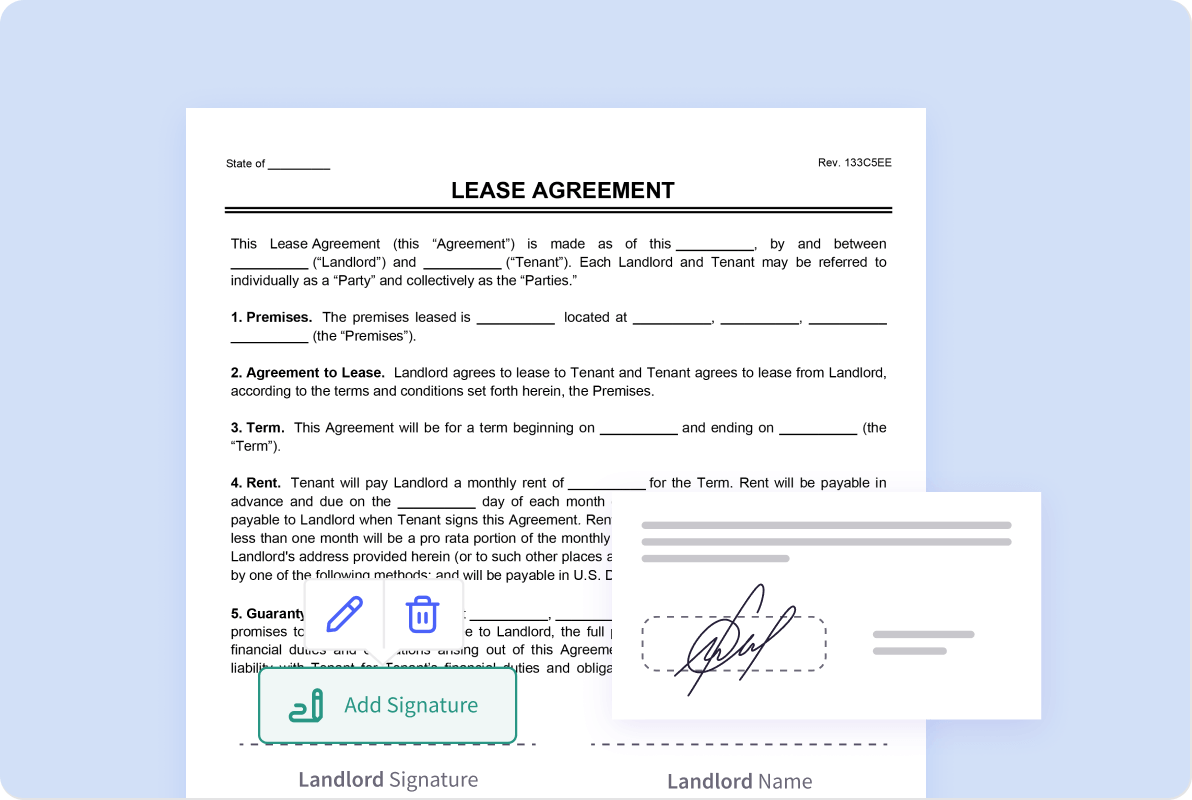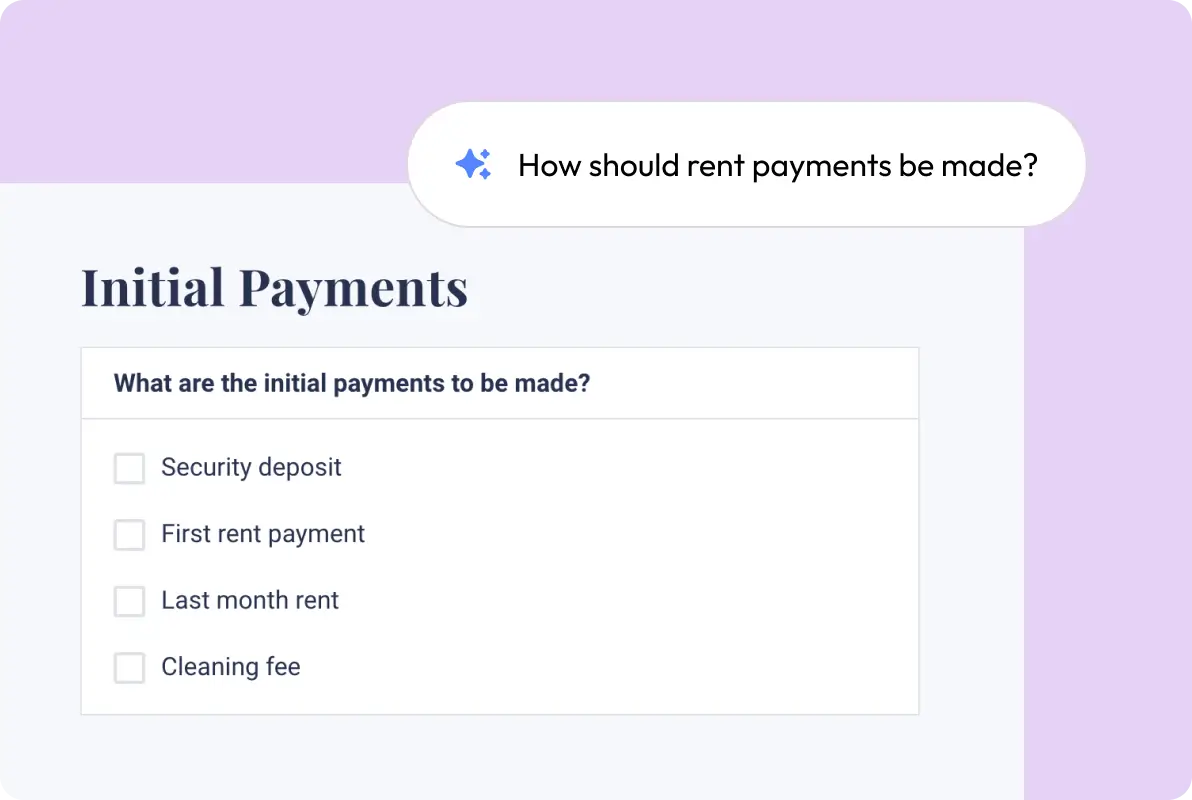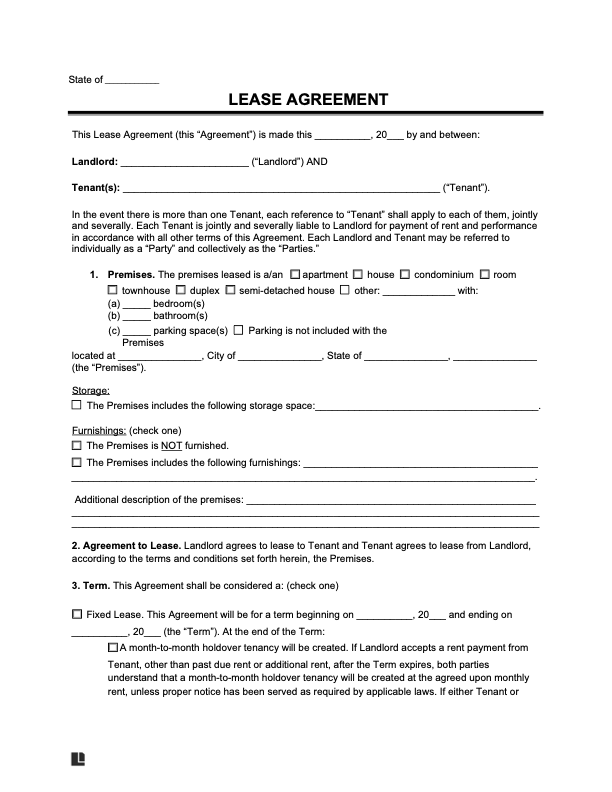What Is a Lease Agreement
A lease agreement is a legal document between a landlord and a tenant. It outlines the terms of the rental, including rent amount, due dates, responsibilities, and rules for the property.
This type of agreement is used when someone rents out a home, apartment, condo, or other residential space. It helps protect both sides by making the terms clear from the start, reducing the chance of confusion or conflict later on.
Our residential lease template makes it easy to create a customized, state-specific agreement you can trust.
Whether you’re a new landlord or managing multiple properties, having a signed lease helps ensure you’re legally protected and your tenants know what to expect.
Why You Need a Residential Lease Agreement
When something goes wrong, the lease offers a clear way to resolve it. That’s why having this document in place is one of the most critical steps in renting a property. Without it, you risk misunderstandings, late payments, surprise guests, or disputes over repairs.
Unlike a verbal agreement, a written lease captures all the important details. People forget things or remember them differently. A signed lease keeps everyone on the same page, especially if there’s ever a legal issue.
For example, a lease might explain that the landlord will handle repairs, respect the tenant’s privacy, and return the security deposit if the property is left in good condition. It also clarifies that the tenant must pay rent on time, cover utilities, and follow rules about pets, guests, and how the home is used.
What Should a Residential Lease Include?
A solid lease agreement sets expectations and protects both parties. At a minimum, it should include:
- Names of all parties (landlord and tenant)
- Property address and description
- Start and end dates
- Monthly rent and when it’s due
- Security deposit amount and refund rules
- Basic rules around guests, pets, maintenance, and rent increases
- Signatures from both the landlord and the tenant
You can also include other terms, like who pays utilities, how much notice is needed to enter the property, or what happens if rent is late.
Our lease template covers all of this, so you don’t miss anything important.
How to Write a Lease Agreement
Follow these simple steps to create a clear, legally binding agreement that protects both you and your tenant.
1. List the Landlord and the Tenant
Start by naming everyone involved. Include the full names and addresses of both the landlord and the tenant. If a property manager is handling the rental, list their info, too.
2. Describe the Property
Next, write down the full address of the rental and what kind of place it is, like an apartment, house, or condo. This makes it clear what’s being rented.
3. Set the Lease Dates
Decide when the lease starts and ends. Most leases are for a fixed term, like 12 months. You can also choose a month-to-month lease if you want more flexibility.
4. Add Rent and Deposit Details
Include the monthly rent amount, when it’s due, and what happens if it’s paid late. You should also list the security deposit and explain when it will be returned.
5. Sign and Save the Lease
Once both sides agree, sign and date the lease. Print a copy for each person, and keep it somewhere safe.
Lease Terms to Know
Here are some helpful definitions for the legal language commonly present in lease and rental agreement forms:
- Access: The right to enter a property.
- Accidents: Artificial or naturally occurring events that may damage a property (fire, flood, earthquake, etc.).
- Alterations: Modifications made to a property.
- Appliances: Standard home equipment like a refrigerator or dishwasher.
- Assignment: The transfer of an interest in a lease.
- Attorney Fees: A payment made to a lawyer.
- Condemnation: The government is seizing private property for a public purpose, such as highway construction.
- Default: When a breach of contract occurs and persists, such as not paying rent or violating other terms of a rental agreement.
- Furniture: Standard home equipment such as couches, tables, beds, etc.
- Guarantor/Co-Signer: Someone accountable for paying rent if the tenant cannot.
- Guests: Short-term occupants of a rental property.
- Joint and Several Liabilities: Two or more people are independently held accountable for damages, regardless of who is at fault.
- Late Rent Fee: An additional, reasonable sum of money paid by a tenant after making a rent payment past the due date listed in the landlord-tenant agreement.
- Noise Policy: A provision outlining “quiet hours” in the apartment building, condominium, or neighborhood.
- Notice: A written announcement of some fact or observation.
- Option to Purchase: The tenant’s right to purchase the rental property later.
- Parking: Designated spaces where the tenant can keep their vehicles.
- Pet Policy: The permission or restriction of a tenant’s ability to have an animal in a rental property.
- Property Maintenance: Involves preserving a rental unit and determining who is responsible for tasks such as cutting the grass, removing the garbage, and unclogging the kitchen and bathroom drains.
- Renewal: A tenant’s option to continue the lease.
- Renter’s Insurance: A paid policy that protects personal belongings against theft or damage.
- Severability: A clause of a lease stating that if one part of the agreement is invalid for any reason, the rest of the lease is still enforceable.
- Smoking Policy: The permission or restriction of a tenant’s smoking ability inside a rental property.
- Sublet: A temporary housing arrangement between current and new tenants to rent all or part of the currently leased property. The subletting period must be for less than the lease term.
- Successor: Someone who takes over the obligations of a lease from a tenant or landlord.
- Utilities: A public or private service supplying electricity, water, gas, or trash collection to a property.
- Waterbed: A water-filled furnishing used to sleep and not typically permitted in most rental properties.







